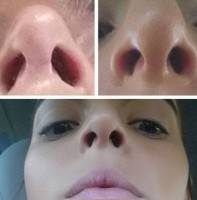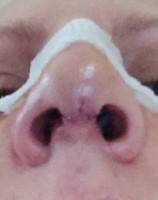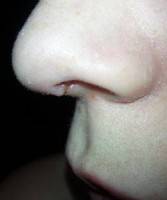Scar after rhinoplasty
Nose job Scarring
If you undergo a ‘closed’ rhinoplasty procedure, there should be no visible scarring since all of the incisions are made inside of the nose.
With an ‘open’ rhinoplasty approach, I will make an inverted V shaped incision between the nostrils to access the tip and bridge.
This scar typically heals very nicely without any obvious signs of having an incision. Initially, the scar may look slightly raised off the surface of the skin (what we call everted).
This is done intentionally to account for the fact the scar will flatten with time. If you have a wide or flared nasal base, I might recommend a rhinoplasty maneuver to narrow the nose using additional incisions.
These are placed either at the attachment of the nose to the cheek and/or just inside of the nostril (called a sill incision). These incisions also heal quite nicely in most cases. (John M. Hilinski, MD, San Diego Facial Plastic Surgeon)
Visible Scars after Rhinoplasty
With a closed rhinoplasty, all incisions are made wthin the nose. Many surgeons,including myself, feel there is a distinct advantage to the open, or external approach, in certain certain noses such as revision rhinoplasties because in their hands there is improved exposure of the anatomy and the results are more predictable.
With this technique the skin incision made between the nostrils heals very well; in 35 years, I’ve revised this incision twice. (Richard W. Fleming, MD, Beverly Hills Facial Plastic Surgeon)
Does rhinoplasty leave a visible scar?
A well performed rhinoplasty should not leave a visible scar. Even though, an open approach to the rhinoplasty requires an incision in the columella skin (between the nostrils), the scar is typically not visible. The same can be said about narrowing of the nostrils. Please view the photographs in this link to see the results of surgery where the columella and the nostrils were cut. (Maurice M. Khosh, MD, New York Facial Plastic Surgeon)
Nasal scars after rhinoplasty
Most nose surgery is done with the incisions inside. When a patient needs an open approach, the incision is done on the columella (the area between the nostrils).
This incision usually fades over a period of a few weeks. If the nostrils need to be narrowed another incision may be done on the side of the nostril and inside the nostrils. These usually fade as well. (Carlos Wolf, MD, Miami Facial Plastic Surgeon)
At most, a few millimeter scar between the nostrils
External or open rhinoplasty will require placement of an incision between the nostrils. But because that skin is so thin and deilcate, if sutured carefully, the scar should heal to the point it is nearly invisible within a few months. With closed or endonasal rhinoplasty there is no visible scars. (David W. Kim, MD, Bay Area Facial Plastic Surgeon)
Rhinoplasty scars
Rhinoplasty can be performed with two approaches. One is the endonasal or “closed ” approach, where all of the incisions are hidden inside the nose. The other approach is the “open” approach, where there is a small hidden incision in the columella. This incision heals very well and should not be a concern. One approach is not better than the other. The best approach for you is the one your surgeon is most comfortable with so that you may have the best result possible in his hands. (Andres Bustillo, MD, FACS, Miami Facial Plastic Surgeon)
There should be no visible scars from a nose job
There should be no visible scars from a nose job, because the all incisions should be made on the inside of the nose. I strongly advise that you avoid doctors who do open rhinoplasties, becasue making an external cut is positively unnecessary and always leaves some type of a scar.
I also believe that inferioor results are acheived when an open rhinoplasty is performed. For an experienced plastic surgeon, all the nasal structures can be visualized and operated upon completely and accurately through the inside of then nose. I have done over 5000 rhinoplasties – not one of them “open.” (Howard T. Bellin, MD (retired), Manhattan Plastic Surgeon)
The technique determines the placement of incisions
If the surgeon needs to make a small incision under your nose you will have a small scar. This scar is usually not too visible.
If the surgeon uses a technique where all incisions are placed in the nose, no external scar will be visible. Which technique used depends on the type of changes needed. (Robert Mounsey, MD, Toronto Facial Plastic Surgeon)
For many years, the traditional approach to nasal surgery has involved only internal nasal incisions. This type of approach is considered an “endonasal” or “closed” approach.
This is still the most commonly used technique, so that visible scars from nasal surgery are uncommon. Occasionally, an “open” approach is more appropriate – for complicated refinements of the nasal tip, post traumatic nasal surgery, or revision nasal surgery.
This involves a very small incision on the descending portion of the skin between the tip of the nose and the white upper lip, known as the “collumela.
The good news is even if a collumelar is required, the skin in this location heals so well that a scar here is very difficult to identify.
The remainder of the incision is made inside the nose. As a result, scars following nasal surgery are not something you generally need to worry about (Michael R. Macdonald, MD, Bay Area Facial Plastic Surgeon)
Rhinoplasty can be performed with imperceptible scars
Rhinoplasty can be performed with imperceptible scars. If one uses an endonasal/closed approach, then all the scars will be on the inside of the nose unless the nostrils require reduction.
An open approach uses a small external incision on the underside of the nose in addition to internal incisions, however, if performed well, the scar is imperceptible in most cases. (Sanjay Grover, MD, Orange County Plastic Surgeon)
Scarring after a rhinoplasty
Rhinoplasty is a popular and effective surgery to recontour the shape of your nose. Today, there are two main techniques for rhinoplasty surgery: the open technique and the closed technique. The open technique is when the surgeon lift the skin off your nose to work on the deeper structures. This will produce a scar on the inner surface of your nostrils that is not possible to see from the outside.
You also have a small scar in the columella which is the portion of your nose between your two nostrils. This area body heals extremely well and the scars are usually not noticeable here either. A closed rhinoplasty only uses an incision on the inner surface of your nostril thus producing a scar that is not noticeable. (Pat Pazmino, MD, Miami Plastic Surgeon)
Are scars visible after Rhinoplasty?
Sometimes Rhinoplasty is done using a small incision under the nose. It heals leaving an almost invisible line. Less commonly 2mm incisions are made at the side of the nasal bridge to help narrow it. These too heal very well. (Oakley Smith, MD, Toronto Facial Plastic Surgeon)
Avoiding scars in rhinoplasty
There are two primary access approaches in rhinoplasty. The so called “closed” method where all the incisions are on the inside of the nose, therefore no visible scar; and “open ” approach where there is an incision across the columella. This incision typically heals well, but on occasion in can leave somewhat noticeable scar. In my practice I perform primarily closed /endonasal rhinoplasty. I believe this approach allows for a more finessed result in some patients. Ultimately the most important thing if for the surgeon to consistantly deliver plesing results with whatever approach he/she is most confortable with. (Boris M. Ackerman, MD, Newport Beach Plastic Surgeon)
Rhinoplasty / Nose job incision scar
Even with the external approach, this incision typically heals as a fine line scar. (Jeffrey Epstein, MD, FACS, Miami Facial Plastic Surgeon)
Rhinoplasty techniques have been perfected for decades in order to minimize scarring and improve a natural nasal contour.
An open rhinoplasty places an additional external scar on the nose but the scar usually fades within weeks. (Raffy Karamanoukian, MD, FACS, Los Angeles Plastic Surgeon)
Open vs closed rhinoplasty pearls
Most tip work is done with the open Rhinoplasty technique and most noses that require only bridge work are done with the closed technique.
These are just guidelines and not absolutes but your surgeon will have his preferences and should discuss them with you. (Jason B. Diamond, MD, Beverly Hills Facial Plastic Surgeon)
Almost undetectable scar with open approach
There are two approaches to rhinoplasties: the open and closed approach. The open approach does require a small incision in your columella, but when performed well leaves a scar that is almost invisible.
For many rhinoplasty goals, most surgeons will use the open approach. There are some cases (such as isolated dorsal hump, simple crooked nose) that can be treated well with the closed approach. There are also some surgeons that will do many rhinoplasties through the closed approach. In our opinion, the open approach offers the advantage of accurate analysis of the patient’s nose and best exposure to modify the nose. In our hands, this approach gives the best and most consistent results. Current training in the U.S. heavily favors the open approach. (Corey S. Maas, MD, San Francisco Facial Plastic Surgeon)
For most patients, there is no need for visible scar on the nose
Our most common approach to re-shaping the nose is through what is called a “closed” rhinoplasty approach. This implies that incisions to gain access to the nose are on the inside of the nose, and although there are scars, they are not generally visible to the patient or the public.
In some instances, where we are revising a previous rhinoplasty, or where a great deal of work is required on the nasal tip, we use an “open” Rhinoplasty approach, which adds a small incision on the underside of the nose (the columella) in addition to internal incisions. Although this is potentially a visible scar, because it is hidden on the underside of the nose, and because it tends to heal well, you have to look for it to see it. (Michael H. Rosenberg, MD, White Plains Plastic Surgeon)
The end justifies the means when it comes to Rhinoplasty scarring
There are two surgical maneuvers in Rhinoplasty or Nasal Cosmetic Surgery that result in a potentially visible scar on the surface of the nose. First and most common is the technique of Open Rhinoplasty. Here the surgeon makes an incision in the columellar, the structure dividing the nostrils. Working through this cut the surgeon peels the skin off the underlying cartilages of the tip. This approach provides excellent visualization for sculpting these cartilages to achieve tip refinement.
This results in a scar across the columella. For individuals requiring a reduction in the flare of their nostrils a direct excision of the base of the nostril where it contacts the upper lip is performed. This results in a scar at the nostril-lip junction. Given the surgeon carefully sutures these incisions both will heal with virtually invisible scars. These scars are certainly a small price to pay if you require nasal tip or nostril flare reduction as a component of your Rhinoplasty. (David A. Ross, MD, Chicago Plastic Surgeon)
Scars after Rhinoplasty
There are two types of rhinoplasty: closed and open. In the closed technique, which is the traditional method, all the incisions are made inside the nose, unless your nasal ala (nostrils) are too wide. In that case, an incision is made to remove the excess nostril and make your nostrils narrower.
This is typically done in African-American noses. The open technique, which is the most common method used today, uses the same incisions as the traditional method. In addition, there is an incision underneath the columella (the bridge of skin which attaches your nose to the center of your face, above the lip). The advantage of the open technique is three dimensional view of the entire nose, allowing more accurate and predictable result. If your rhinoplasty is performed by a well-trained plastic surgeon, the risk of noticeable scarring, with either technique, is very low. (Michael A. Jazayeri, MD, Santa Ana Plastic Surgeon)
Usually no visible scars for a rhinoplasty
Rhinoplasties are usually done with an “open” or “closed’ technique. The difference is where the incisions are made. With the closed technique, all incisions are hidden inside the nose. With an open approach, there is an incision on the bottom portion of the nose, but it usually heals exceptionally well and therefore is almost invisible.
Some patients are better treated with one approach vs. the other, depending on what is needed to be done at surgery. Talk to your doctor about both approaches! (Dean Fardo, MD, Atlanta Plastic Surgeon)
Rhinoplasty: Open versus Closed Approaches and Scarring
There are two approaches to rhinoplasty: open rhinoplasty and closed rhinoplasty. In closed rhinoplasty, all the incisision are placed on the inside of the nose and no external scars are visible. Open rhinoplasty uses the same incisions as closed rhinoplasty with the addition of a small incision across the undersurface of narrowest portion of the column of tissue between your nostrils.
With time, this scar is virtually unrecognizable at conversational distances. Alar base reductions (nostril reduction) is a common technique used in both open and closed rhinoplasty.
The nostrils can be narrowed (or flaring reducted) by excising a small crescent shaped wedge of tissue where your nostril meets your cheek. This does produce an external scar, even if the rhinoplasty itself was performed closed. The vast majority of times, if performed correctly, alar base reduction does not produce noticable scars. (C. Spencer Cochran, MD, Dallas Facial Plastic Surgeon)


